Recycling Quality - MRF | Assignment
VerifiedAdded on 2022/08/26
|7
|1663
|20
AI Summary
Contribute Materials
Your contribution can guide someone’s learning journey. Share your
documents today.
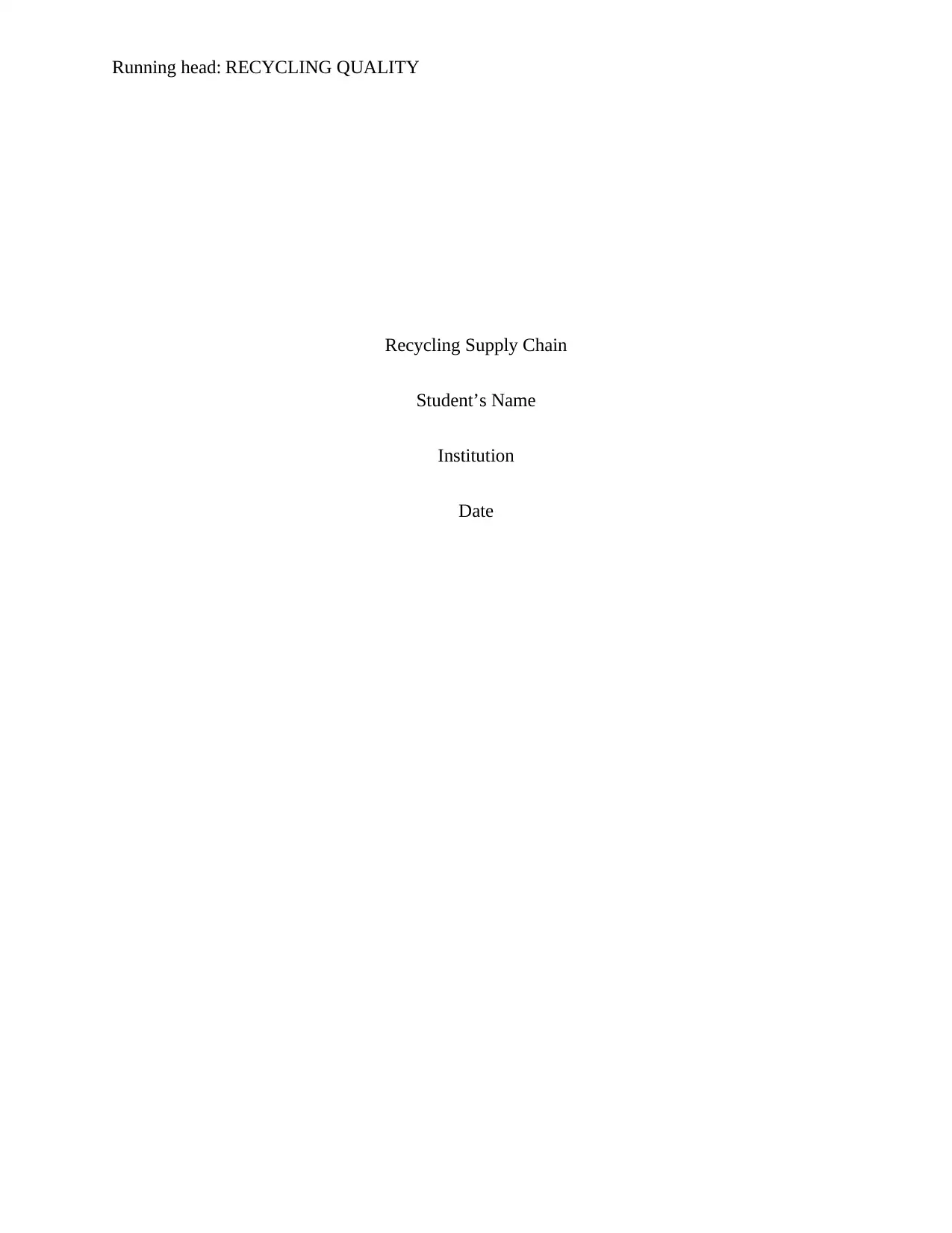
Running head: RECYCLING QUALITY
Recycling Supply Chain
Student’s Name
Institution
Date
Recycling Supply Chain
Student’s Name
Institution
Date
Secure Best Marks with AI Grader
Need help grading? Try our AI Grader for instant feedback on your assignments.
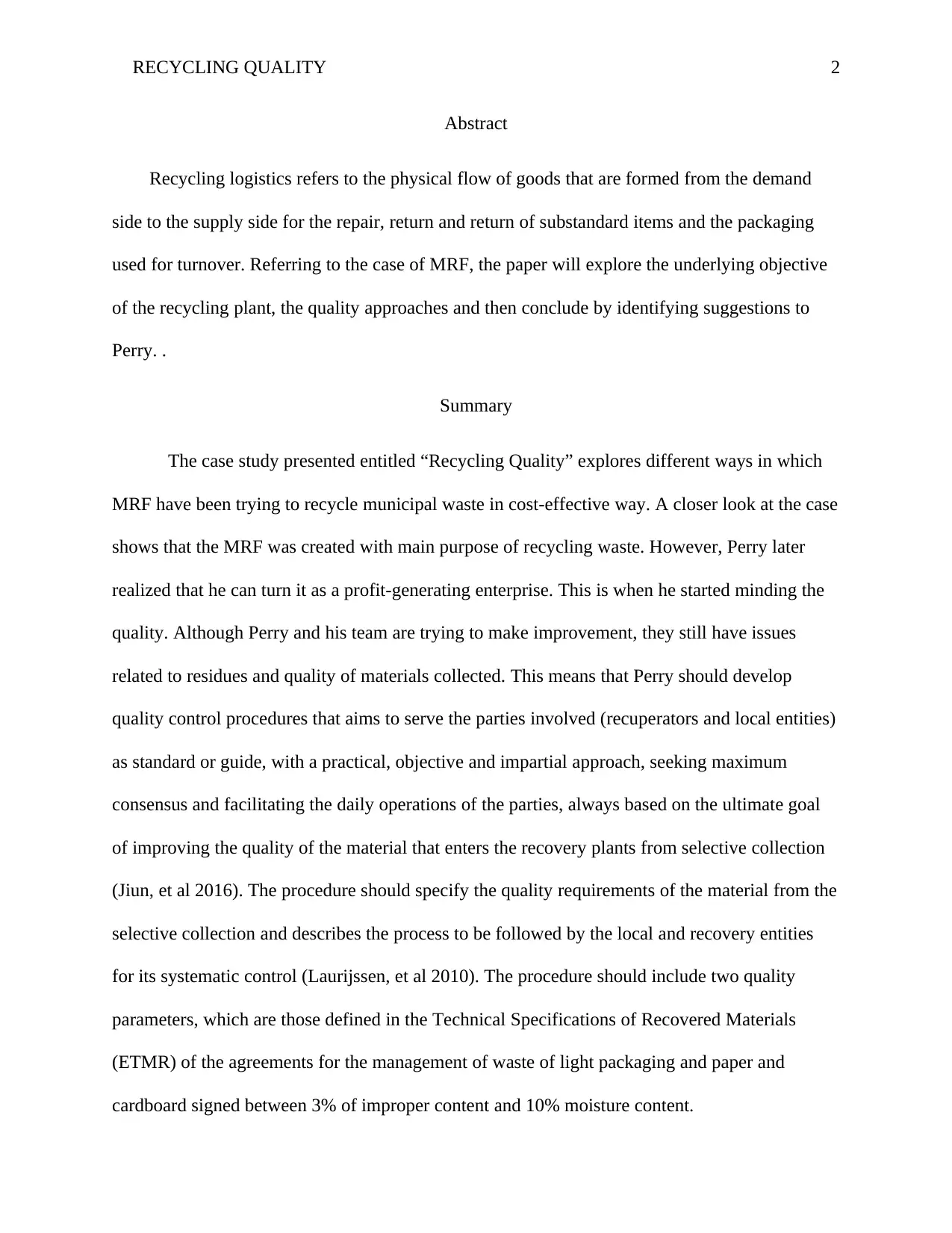
RECYCLING QUALITY 2
Abstract
Recycling logistics refers to the physical flow of goods that are formed from the demand
side to the supply side for the repair, return and return of substandard items and the packaging
used for turnover. Referring to the case of MRF, the paper will explore the underlying objective
of the recycling plant, the quality approaches and then conclude by identifying suggestions to
Perry. .
Summary
The case study presented entitled “Recycling Quality” explores different ways in which
MRF have been trying to recycle municipal waste in cost-effective way. A closer look at the case
shows that the MRF was created with main purpose of recycling waste. However, Perry later
realized that he can turn it as a profit-generating enterprise. This is when he started minding the
quality. Although Perry and his team are trying to make improvement, they still have issues
related to residues and quality of materials collected. This means that Perry should develop
quality control procedures that aims to serve the parties involved (recuperators and local entities)
as standard or guide, with a practical, objective and impartial approach, seeking maximum
consensus and facilitating the daily operations of the parties, always based on the ultimate goal
of improving the quality of the material that enters the recovery plants from selective collection
(Jiun, et al 2016). The procedure should specify the quality requirements of the material from the
selective collection and describes the process to be followed by the local and recovery entities
for its systematic control (Laurijssen, et al 2010). The procedure should include two quality
parameters, which are those defined in the Technical Specifications of Recovered Materials
(ETMR) of the agreements for the management of waste of light packaging and paper and
cardboard signed between 3% of improper content and 10% moisture content.
Abstract
Recycling logistics refers to the physical flow of goods that are formed from the demand
side to the supply side for the repair, return and return of substandard items and the packaging
used for turnover. Referring to the case of MRF, the paper will explore the underlying objective
of the recycling plant, the quality approaches and then conclude by identifying suggestions to
Perry. .
Summary
The case study presented entitled “Recycling Quality” explores different ways in which
MRF have been trying to recycle municipal waste in cost-effective way. A closer look at the case
shows that the MRF was created with main purpose of recycling waste. However, Perry later
realized that he can turn it as a profit-generating enterprise. This is when he started minding the
quality. Although Perry and his team are trying to make improvement, they still have issues
related to residues and quality of materials collected. This means that Perry should develop
quality control procedures that aims to serve the parties involved (recuperators and local entities)
as standard or guide, with a practical, objective and impartial approach, seeking maximum
consensus and facilitating the daily operations of the parties, always based on the ultimate goal
of improving the quality of the material that enters the recovery plants from selective collection
(Jiun, et al 2016). The procedure should specify the quality requirements of the material from the
selective collection and describes the process to be followed by the local and recovery entities
for its systematic control (Laurijssen, et al 2010). The procedure should include two quality
parameters, which are those defined in the Technical Specifications of Recovered Materials
(ETMR) of the agreements for the management of waste of light packaging and paper and
cardboard signed between 3% of improper content and 10% moisture content.
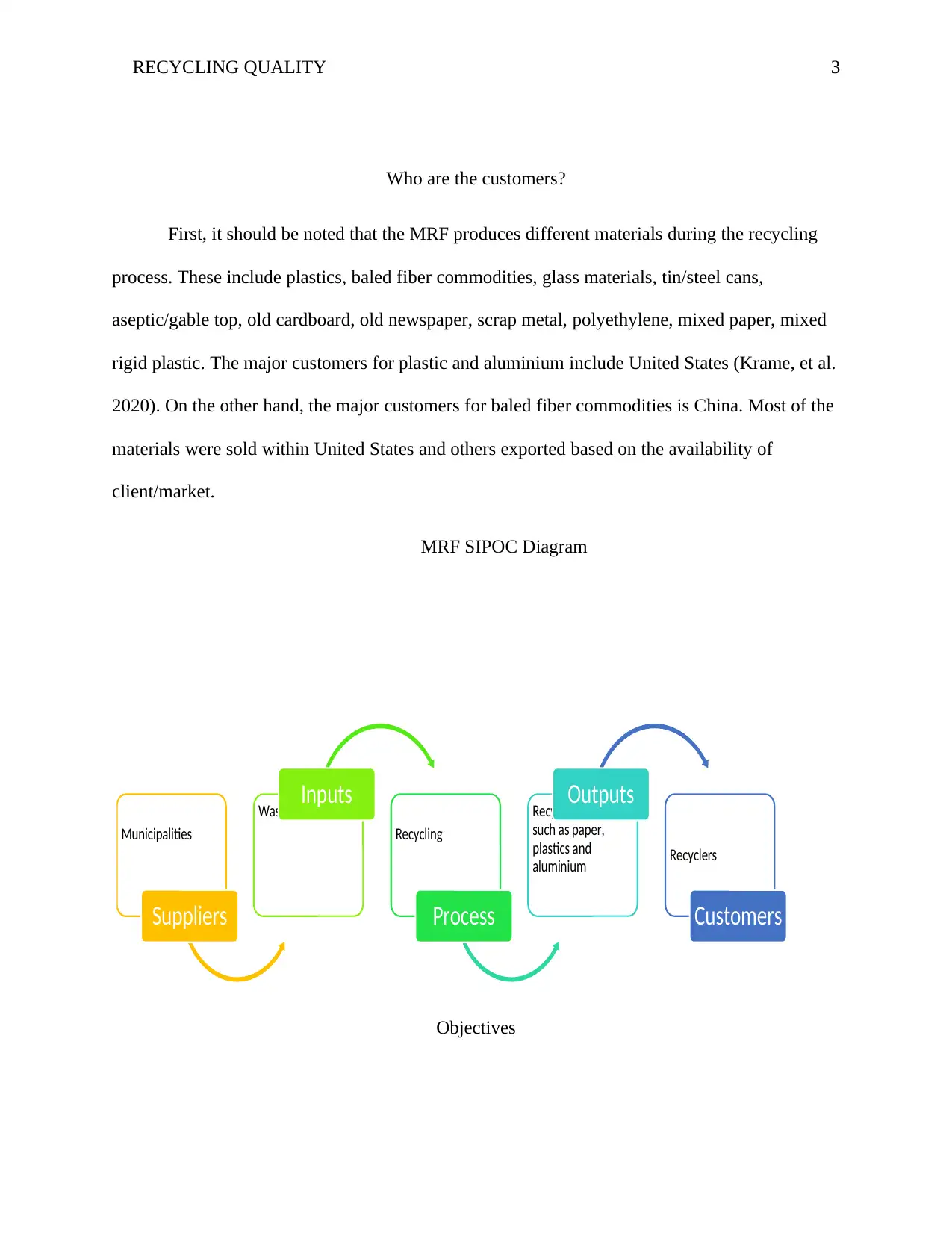
RECYCLING QUALITY 3
Who are the customers?
First, it should be noted that the MRF produces different materials during the recycling
process. These include plastics, baled fiber commodities, glass materials, tin/steel cans,
aseptic/gable top, old cardboard, old newspaper, scrap metal, polyethylene, mixed paper, mixed
rigid plastic. The major customers for plastic and aluminium include United States (Krame, et al.
2020). On the other hand, the major customers for baled fiber commodities is China. Most of the
materials were sold within United States and others exported based on the availability of
client/market.
MRF SIPOC Diagram
Objectives
Municipalities
Suppliers
Waste products
Inputs
Recycling
Process
Recycled materials
such as paper,
plastics and
aluminium
Outputs
Recyclers
Customers
Who are the customers?
First, it should be noted that the MRF produces different materials during the recycling
process. These include plastics, baled fiber commodities, glass materials, tin/steel cans,
aseptic/gable top, old cardboard, old newspaper, scrap metal, polyethylene, mixed paper, mixed
rigid plastic. The major customers for plastic and aluminium include United States (Krame, et al.
2020). On the other hand, the major customers for baled fiber commodities is China. Most of the
materials were sold within United States and others exported based on the availability of
client/market.
MRF SIPOC Diagram
Objectives
Municipalities
Suppliers
Waste products
Inputs
Recycling
Process
Recycled materials
such as paper,
plastics and
aluminium
Outputs
Recyclers
Customers
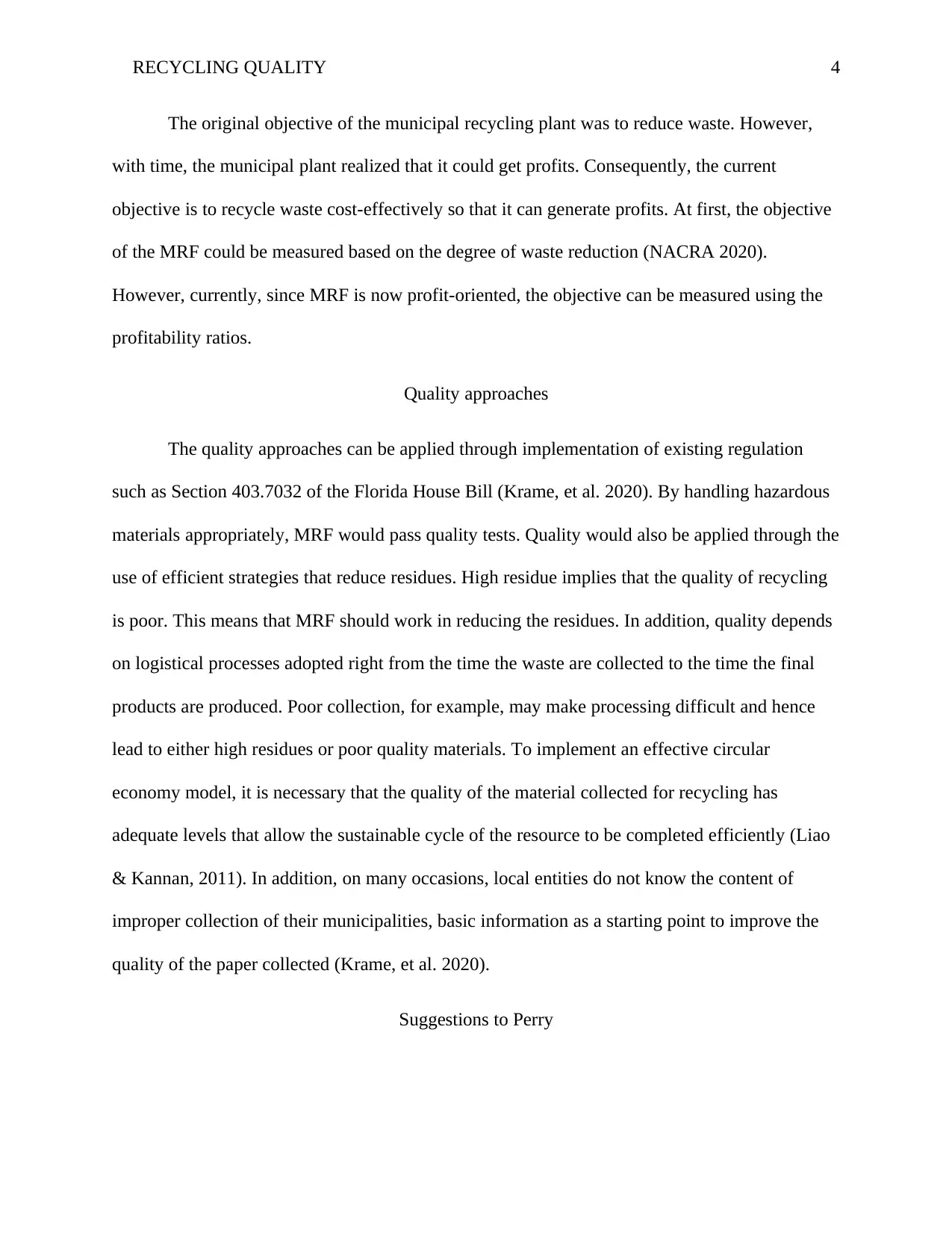
RECYCLING QUALITY 4
The original objective of the municipal recycling plant was to reduce waste. However,
with time, the municipal plant realized that it could get profits. Consequently, the current
objective is to recycle waste cost-effectively so that it can generate profits. At first, the objective
of the MRF could be measured based on the degree of waste reduction (NACRA 2020).
However, currently, since MRF is now profit-oriented, the objective can be measured using the
profitability ratios.
Quality approaches
The quality approaches can be applied through implementation of existing regulation
such as Section 403.7032 of the Florida House Bill (Krame, et al. 2020). By handling hazardous
materials appropriately, MRF would pass quality tests. Quality would also be applied through the
use of efficient strategies that reduce residues. High residue implies that the quality of recycling
is poor. This means that MRF should work in reducing the residues. In addition, quality depends
on logistical processes adopted right from the time the waste are collected to the time the final
products are produced. Poor collection, for example, may make processing difficult and hence
lead to either high residues or poor quality materials. To implement an effective circular
economy model, it is necessary that the quality of the material collected for recycling has
adequate levels that allow the sustainable cycle of the resource to be completed efficiently (Liao
& Kannan, 2011). In addition, on many occasions, local entities do not know the content of
improper collection of their municipalities, basic information as a starting point to improve the
quality of the paper collected (Krame, et al. 2020).
Suggestions to Perry
The original objective of the municipal recycling plant was to reduce waste. However,
with time, the municipal plant realized that it could get profits. Consequently, the current
objective is to recycle waste cost-effectively so that it can generate profits. At first, the objective
of the MRF could be measured based on the degree of waste reduction (NACRA 2020).
However, currently, since MRF is now profit-oriented, the objective can be measured using the
profitability ratios.
Quality approaches
The quality approaches can be applied through implementation of existing regulation
such as Section 403.7032 of the Florida House Bill (Krame, et al. 2020). By handling hazardous
materials appropriately, MRF would pass quality tests. Quality would also be applied through the
use of efficient strategies that reduce residues. High residue implies that the quality of recycling
is poor. This means that MRF should work in reducing the residues. In addition, quality depends
on logistical processes adopted right from the time the waste are collected to the time the final
products are produced. Poor collection, for example, may make processing difficult and hence
lead to either high residues or poor quality materials. To implement an effective circular
economy model, it is necessary that the quality of the material collected for recycling has
adequate levels that allow the sustainable cycle of the resource to be completed efficiently (Liao
& Kannan, 2011). In addition, on many occasions, local entities do not know the content of
improper collection of their municipalities, basic information as a starting point to improve the
quality of the paper collected (Krame, et al. 2020).
Suggestions to Perry
Paraphrase This Document
Need a fresh take? Get an instant paraphrase of this document with our AI Paraphraser
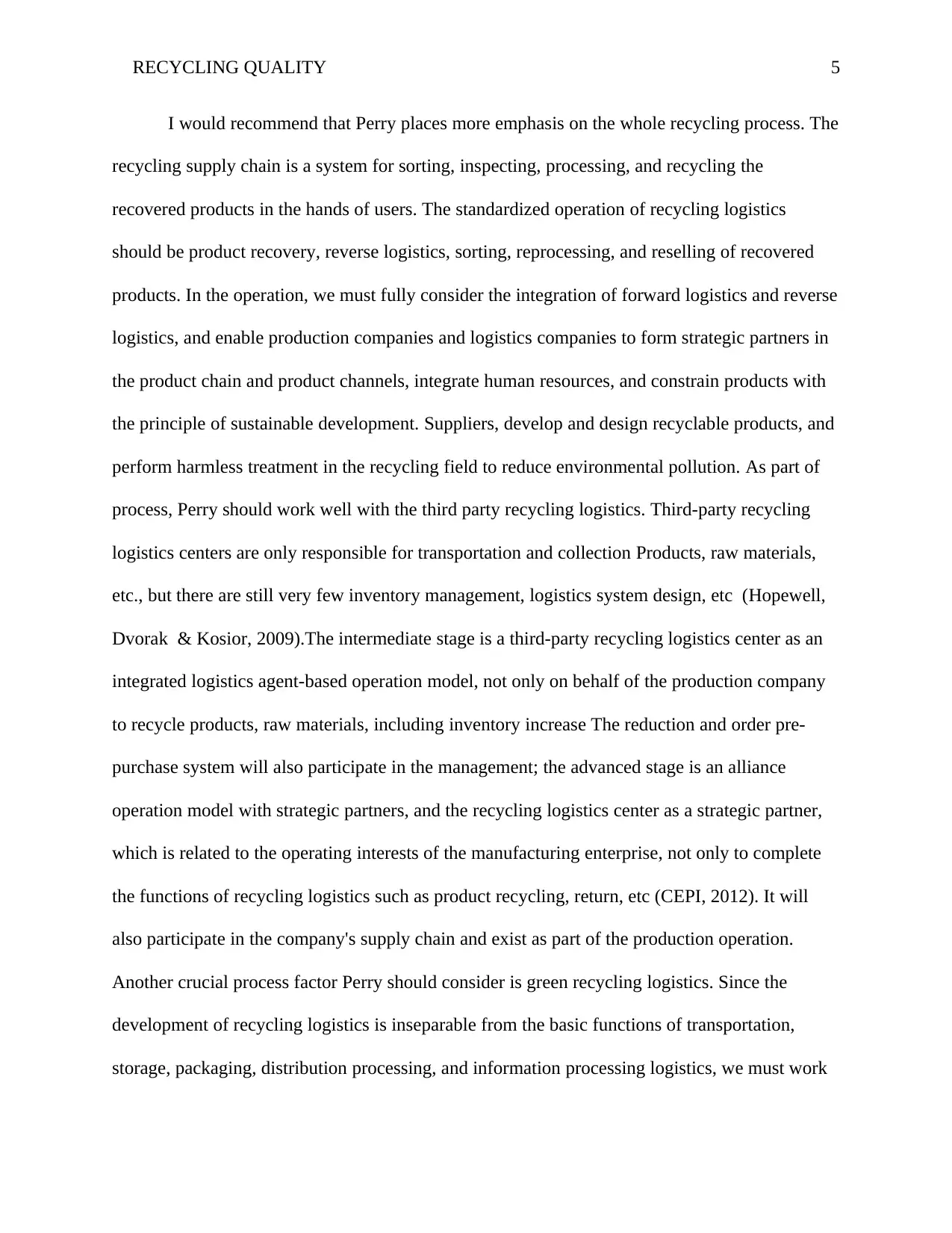
RECYCLING QUALITY 5
I would recommend that Perry places more emphasis on the whole recycling process. The
recycling supply chain is a system for sorting, inspecting, processing, and recycling the
recovered products in the hands of users. The standardized operation of recycling logistics
should be product recovery, reverse logistics, sorting, reprocessing, and reselling of recovered
products. In the operation, we must fully consider the integration of forward logistics and reverse
logistics, and enable production companies and logistics companies to form strategic partners in
the product chain and product channels, integrate human resources, and constrain products with
the principle of sustainable development. Suppliers, develop and design recyclable products, and
perform harmless treatment in the recycling field to reduce environmental pollution. As part of
process, Perry should work well with the third party recycling logistics. Third-party recycling
logistics centers are only responsible for transportation and collection Products, raw materials,
etc., but there are still very few inventory management, logistics system design, etc (Hopewell,
Dvorak & Kosior, 2009).The intermediate stage is a third-party recycling logistics center as an
integrated logistics agent-based operation model, not only on behalf of the production company
to recycle products, raw materials, including inventory increase The reduction and order pre-
purchase system will also participate in the management; the advanced stage is an alliance
operation model with strategic partners, and the recycling logistics center as a strategic partner,
which is related to the operating interests of the manufacturing enterprise, not only to complete
the functions of recycling logistics such as product recycling, return, etc (CEPI, 2012). It will
also participate in the company's supply chain and exist as part of the production operation.
Another crucial process factor Perry should consider is green recycling logistics. Since the
development of recycling logistics is inseparable from the basic functions of transportation,
storage, packaging, distribution processing, and information processing logistics, we must work
I would recommend that Perry places more emphasis on the whole recycling process. The
recycling supply chain is a system for sorting, inspecting, processing, and recycling the
recovered products in the hands of users. The standardized operation of recycling logistics
should be product recovery, reverse logistics, sorting, reprocessing, and reselling of recovered
products. In the operation, we must fully consider the integration of forward logistics and reverse
logistics, and enable production companies and logistics companies to form strategic partners in
the product chain and product channels, integrate human resources, and constrain products with
the principle of sustainable development. Suppliers, develop and design recyclable products, and
perform harmless treatment in the recycling field to reduce environmental pollution. As part of
process, Perry should work well with the third party recycling logistics. Third-party recycling
logistics centers are only responsible for transportation and collection Products, raw materials,
etc., but there are still very few inventory management, logistics system design, etc (Hopewell,
Dvorak & Kosior, 2009).The intermediate stage is a third-party recycling logistics center as an
integrated logistics agent-based operation model, not only on behalf of the production company
to recycle products, raw materials, including inventory increase The reduction and order pre-
purchase system will also participate in the management; the advanced stage is an alliance
operation model with strategic partners, and the recycling logistics center as a strategic partner,
which is related to the operating interests of the manufacturing enterprise, not only to complete
the functions of recycling logistics such as product recycling, return, etc (CEPI, 2012). It will
also participate in the company's supply chain and exist as part of the production operation.
Another crucial process factor Perry should consider is green recycling logistics. Since the
development of recycling logistics is inseparable from the basic functions of transportation,
storage, packaging, distribution processing, and information processing logistics, we must work
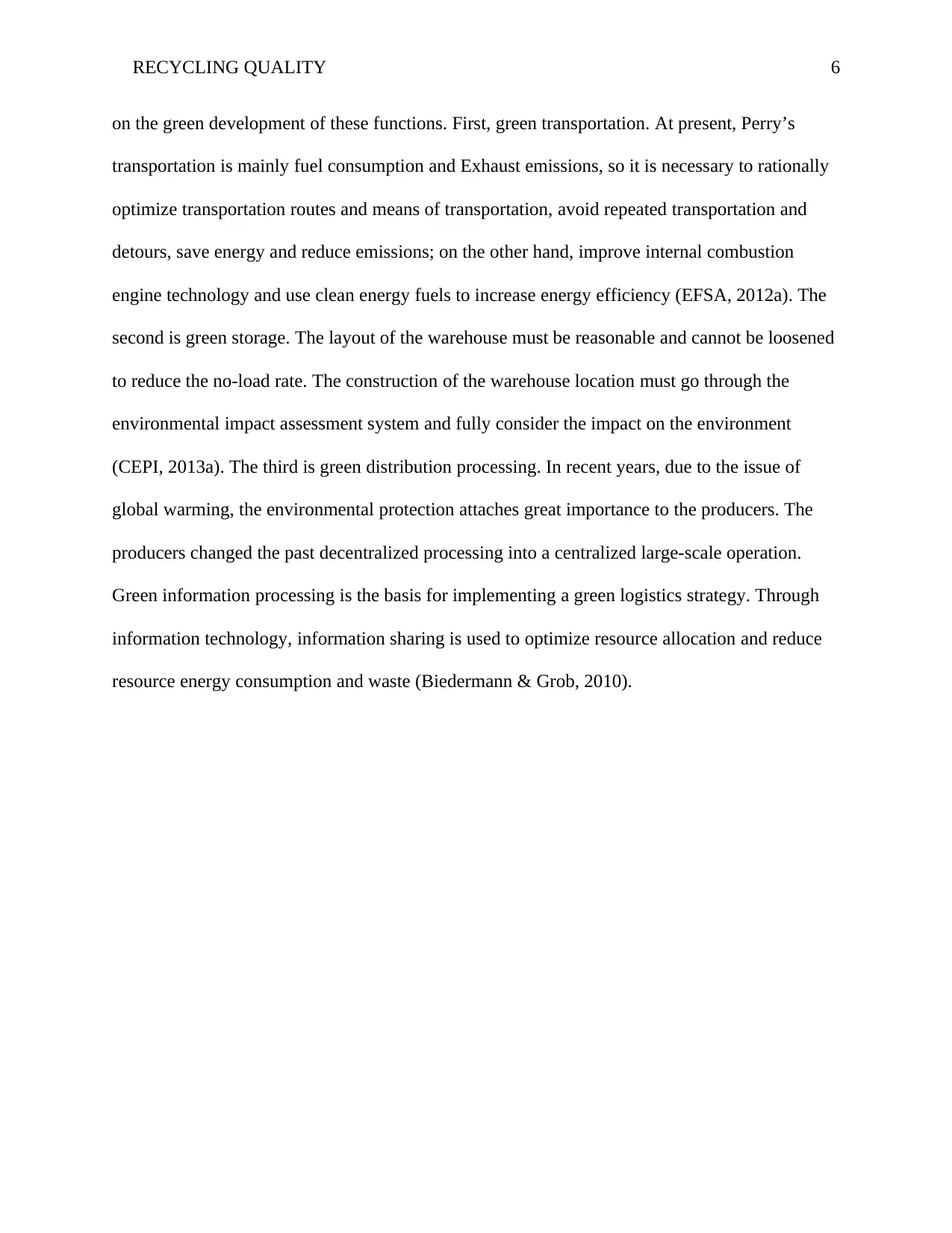
RECYCLING QUALITY 6
on the green development of these functions. First, green transportation. At present, Perry’s
transportation is mainly fuel consumption and Exhaust emissions, so it is necessary to rationally
optimize transportation routes and means of transportation, avoid repeated transportation and
detours, save energy and reduce emissions; on the other hand, improve internal combustion
engine technology and use clean energy fuels to increase energy efficiency (EFSA, 2012a). The
second is green storage. The layout of the warehouse must be reasonable and cannot be loosened
to reduce the no-load rate. The construction of the warehouse location must go through the
environmental impact assessment system and fully consider the impact on the environment
(CEPI, 2013a). The third is green distribution processing. In recent years, due to the issue of
global warming, the environmental protection attaches great importance to the producers. The
producers changed the past decentralized processing into a centralized large-scale operation.
Green information processing is the basis for implementing a green logistics strategy. Through
information technology, information sharing is used to optimize resource allocation and reduce
resource energy consumption and waste (Biedermann & Grob, 2010).
on the green development of these functions. First, green transportation. At present, Perry’s
transportation is mainly fuel consumption and Exhaust emissions, so it is necessary to rationally
optimize transportation routes and means of transportation, avoid repeated transportation and
detours, save energy and reduce emissions; on the other hand, improve internal combustion
engine technology and use clean energy fuels to increase energy efficiency (EFSA, 2012a). The
second is green storage. The layout of the warehouse must be reasonable and cannot be loosened
to reduce the no-load rate. The construction of the warehouse location must go through the
environmental impact assessment system and fully consider the impact on the environment
(CEPI, 2013a). The third is green distribution processing. In recent years, due to the issue of
global warming, the environmental protection attaches great importance to the producers. The
producers changed the past decentralized processing into a centralized large-scale operation.
Green information processing is the basis for implementing a green logistics strategy. Through
information technology, information sharing is used to optimize resource allocation and reduce
resource energy consumption and waste (Biedermann & Grob, 2010).
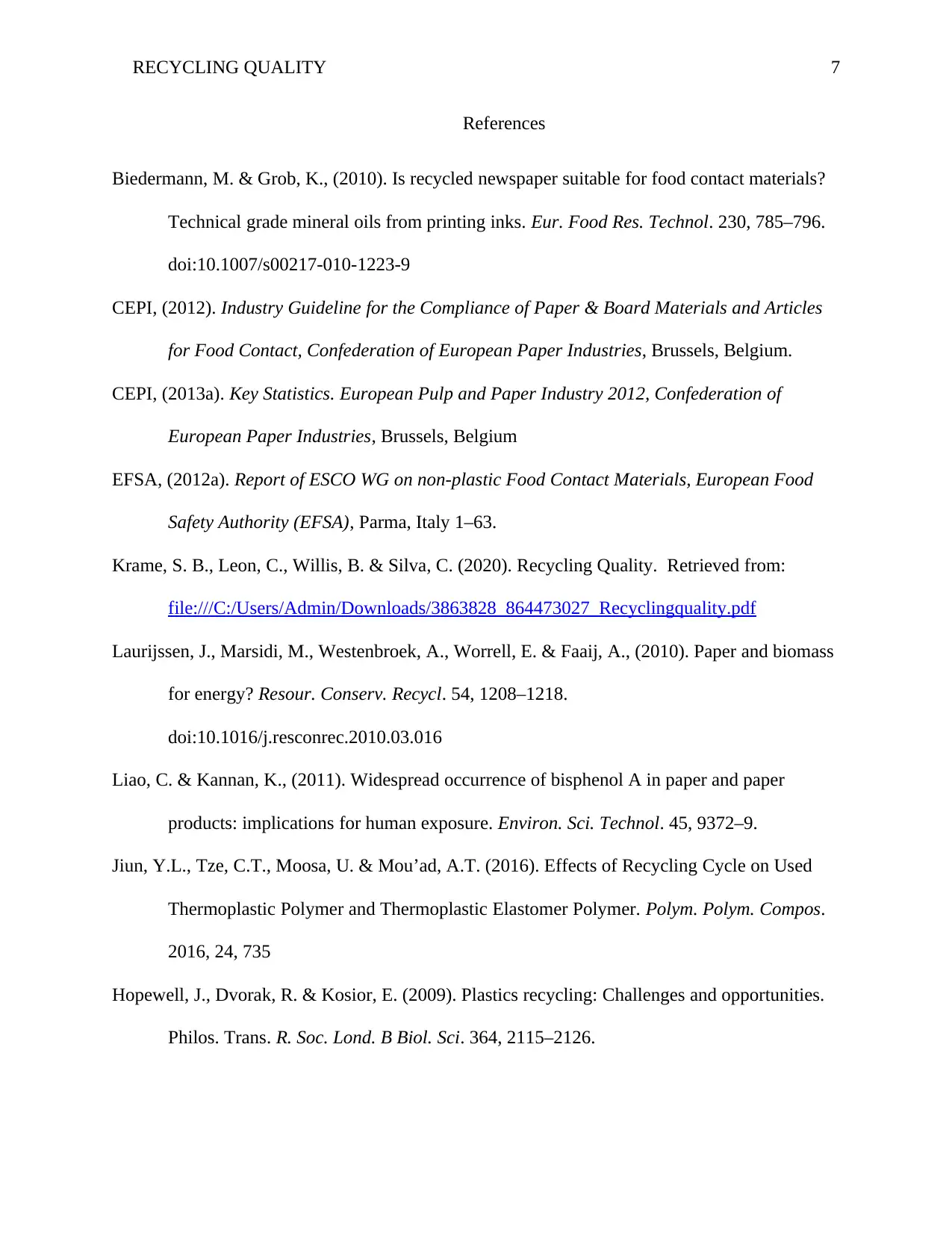
RECYCLING QUALITY 7
References
Biedermann, M. & Grob, K., (2010). Is recycled newspaper suitable for food contact materials?
Technical grade mineral oils from printing inks. Eur. Food Res. Technol. 230, 785–796.
doi:10.1007/s00217-010-1223-9
CEPI, (2012). Industry Guideline for the Compliance of Paper & Board Materials and Articles
for Food Contact, Confederation of European Paper Industries, Brussels, Belgium.
CEPI, (2013a). Key Statistics. European Pulp and Paper Industry 2012, Confederation of
European Paper Industries, Brussels, Belgium
EFSA, (2012a). Report of ESCO WG on non-plastic Food Contact Materials, European Food
Safety Authority (EFSA), Parma, Italy 1–63.
Krame, S. B., Leon, C., Willis, B. & Silva, C. (2020). Recycling Quality. Retrieved from:
file:///C:/Users/Admin/Downloads/3863828_864473027_Recyclingquality.pdf
Laurijssen, J., Marsidi, M., Westenbroek, A., Worrell, E. & Faaij, A., (2010). Paper and biomass
for energy? Resour. Conserv. Recycl. 54, 1208–1218.
doi:10.1016/j.resconrec.2010.03.016
Liao, C. & Kannan, K., (2011). Widespread occurrence of bisphenol A in paper and paper
products: implications for human exposure. Environ. Sci. Technol. 45, 9372–9.
Jiun, Y.L., Tze, C.T., Moosa, U. & Mou’ad, A.T. (2016). Effects of Recycling Cycle on Used
Thermoplastic Polymer and Thermoplastic Elastomer Polymer. Polym. Polym. Compos.
2016, 24, 735
Hopewell, J., Dvorak, R. & Kosior, E. (2009). Plastics recycling: Challenges and opportunities.
Philos. Trans. R. Soc. Lond. B Biol. Sci. 364, 2115–2126.
References
Biedermann, M. & Grob, K., (2010). Is recycled newspaper suitable for food contact materials?
Technical grade mineral oils from printing inks. Eur. Food Res. Technol. 230, 785–796.
doi:10.1007/s00217-010-1223-9
CEPI, (2012). Industry Guideline for the Compliance of Paper & Board Materials and Articles
for Food Contact, Confederation of European Paper Industries, Brussels, Belgium.
CEPI, (2013a). Key Statistics. European Pulp and Paper Industry 2012, Confederation of
European Paper Industries, Brussels, Belgium
EFSA, (2012a). Report of ESCO WG on non-plastic Food Contact Materials, European Food
Safety Authority (EFSA), Parma, Italy 1–63.
Krame, S. B., Leon, C., Willis, B. & Silva, C. (2020). Recycling Quality. Retrieved from:
file:///C:/Users/Admin/Downloads/3863828_864473027_Recyclingquality.pdf
Laurijssen, J., Marsidi, M., Westenbroek, A., Worrell, E. & Faaij, A., (2010). Paper and biomass
for energy? Resour. Conserv. Recycl. 54, 1208–1218.
doi:10.1016/j.resconrec.2010.03.016
Liao, C. & Kannan, K., (2011). Widespread occurrence of bisphenol A in paper and paper
products: implications for human exposure. Environ. Sci. Technol. 45, 9372–9.
Jiun, Y.L., Tze, C.T., Moosa, U. & Mou’ad, A.T. (2016). Effects of Recycling Cycle on Used
Thermoplastic Polymer and Thermoplastic Elastomer Polymer. Polym. Polym. Compos.
2016, 24, 735
Hopewell, J., Dvorak, R. & Kosior, E. (2009). Plastics recycling: Challenges and opportunities.
Philos. Trans. R. Soc. Lond. B Biol. Sci. 364, 2115–2126.
1 out of 7
![[object Object]](/_next/static/media/star-bottom.7253800d.svg)


